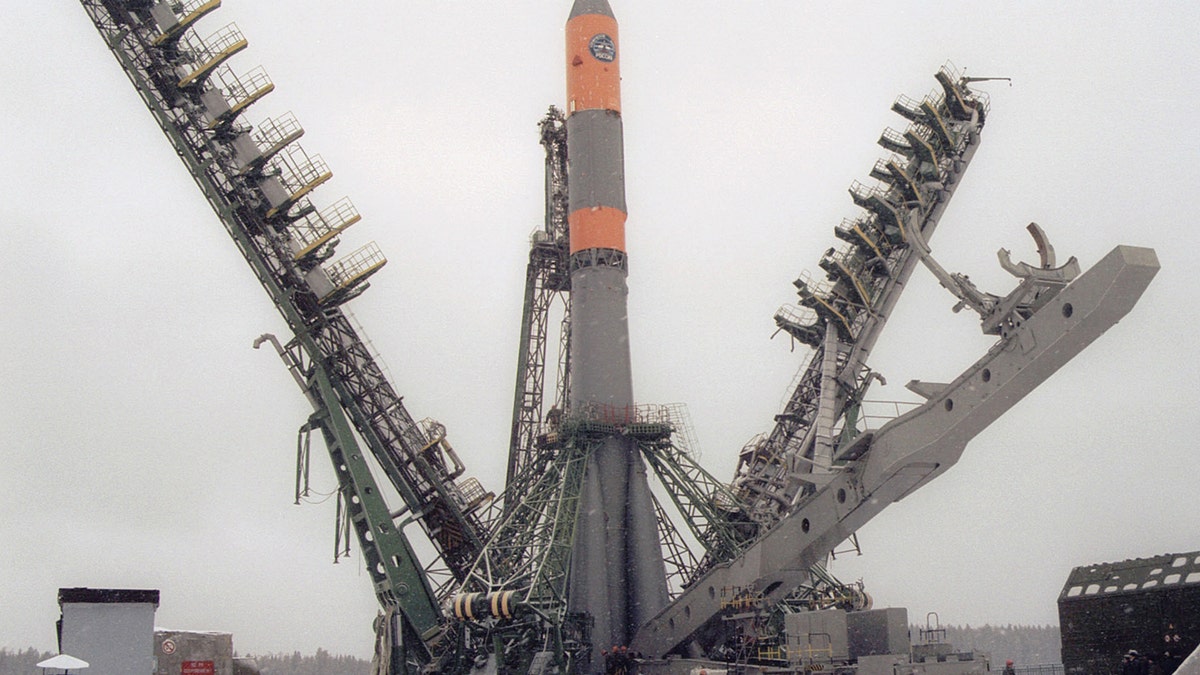
A molniya-m booster rocket is seen at a launching pad of the Plesetsk Cosmodrome shortly before its firing, Arkhangelsk region, Russia, April 2, 2003., (Getty Images)
It's small. It's nimble. It’s doing strange things over our heads. And Russia's new Kosmos 2521 satellite has the potential to bring the world’s economy to its knees.
“We don’t know for certain what it is and there is no way to verify it,” U.S. State Department assistant secretary Yleem Poblete told a conference this week. “But Russian intentions with respect to this satellite are unclear and are obviously a very troubling development — particularly, when considered in concert with statements by Russia’s Space Force Commander.”
She said its maneuvers indicated it could be an anti-satellite weapon.
And this has dire implications: Vital services such as the internet, television, telephone and GPS all rely on satellites. As does a swath of other services — such as weather forecasting and firefighting.
“In October of last year, the Russian Ministry of Defense deployed a space object they claimed was a ‘space apparatus inspector.’ But its behaviour on-orbit was inconsistent with anything seen before from on-orbit inspection or space situational awareness capabilities, including other Russian inspection satellite activities,” Poblete told a conference on disarmament in Switzerland.
Moscow immediately dismissed her comments.
The State Department’s fears were “the same unfounded, slanderous accusations based on suspicions, on suppositions and so on,” Russian diplomat Alexander Deynko told Reuters.
But Russia’s Space Force Commander has already stated publicly it is developing “new prototypes” of space weapons.
Is this one of them?
Whatever the case, the Pentagon is clearly rattled.
“Although US space systems have historically maintained a technological advantage over those of potential adversaries, those potential adversaries are now actively developing way to deny our use of space in a crisis,” a U.S. Department of Defense report released earlier this month reads.
While Poblete did not specify which Russian satellite she was talking about, military analysts believe it was one of a set launched on June 23. A month later, the Russian Ministry of Defence announced it had launched “a small-sized spacecraft has separated from a space platform in order to inspect condition of the Russian satellite.”

Russian President Vladimir Putin (AP)
Kosmos 2521 was believed deployed from another satellite, Kosmos 2519. Close by is another satellite, Kosmos 2523.
Exactly what these Russian satellites have been doing that is “very troubling” is unknown.
But Moscow has reportedly been investing heavily in obtaining the ability for a satellite to move around in orbit and interact with other satellites. This could give it the ability to attach spy equipment to an opponent’s satellite, push it out of alignment, distort its signals, damage it, destroy it — or even potentially capture it.
Destroying a satellite, however, poses immense risks for all space flight activities. Fragments can cannon about above the Earth’s atmosphere for centuries — striking other satellites, and adding their wreckage to the deadly debris fields.
For this reason, the world’s militaries have been looking at ‘non-kinetic’ methods of putting satellites out of service.
This can involve the use of lasers or microwave guns to fry delicate electronics, or jam its signals. And the testing of any such technology would be difficult to discern from simple mechanical failures from the ground.
Russia is working on more than just space-based satellite warfare. It has also deployed, for the first time, ground-based laser batteries aimed at taking the down prying eyes above.
“The Russian Ministry of Defense recently announced that its Space Troops have received a mobile laser system which Vladimir Putin announced to the world on March 1 of this year. Russia’s leader himself alluded to space weapons being ‘more acceptable in the political and military respect’,” Poblete said.
This refers to the Peresvet system President Vladimir Putin referred to when he announced six new ‘super weapons’ to the world earlier this year. The laser is mobile, networking generators, sensors and command-and-control systems packed on the back of trucks.

Russia's military conducts drills in this file photo. (AP)
The laser is claimed to have the ability to shoot-down ballistic missiles in their orbital phase, as well as satellites.
Russia’s space agency Roscosmos is also attempting to ‘weaponise’ a telescope. It wants “an optic detection system which includes a solid-state laser and a transmit/receive adaptive optical system.”
It argues the laser cannon would be able to locate and identify space junk before slagging it.
It argues that there are already 22,000 dead satellites and large pieces of debris being tracked in orbit. In total, estimates place the amount of objects floating around up there at 170 million pieces.
Chinese researchers have also been exploring the use of lasers in space, with the potential of a space-based system being investigated earlier this year.
